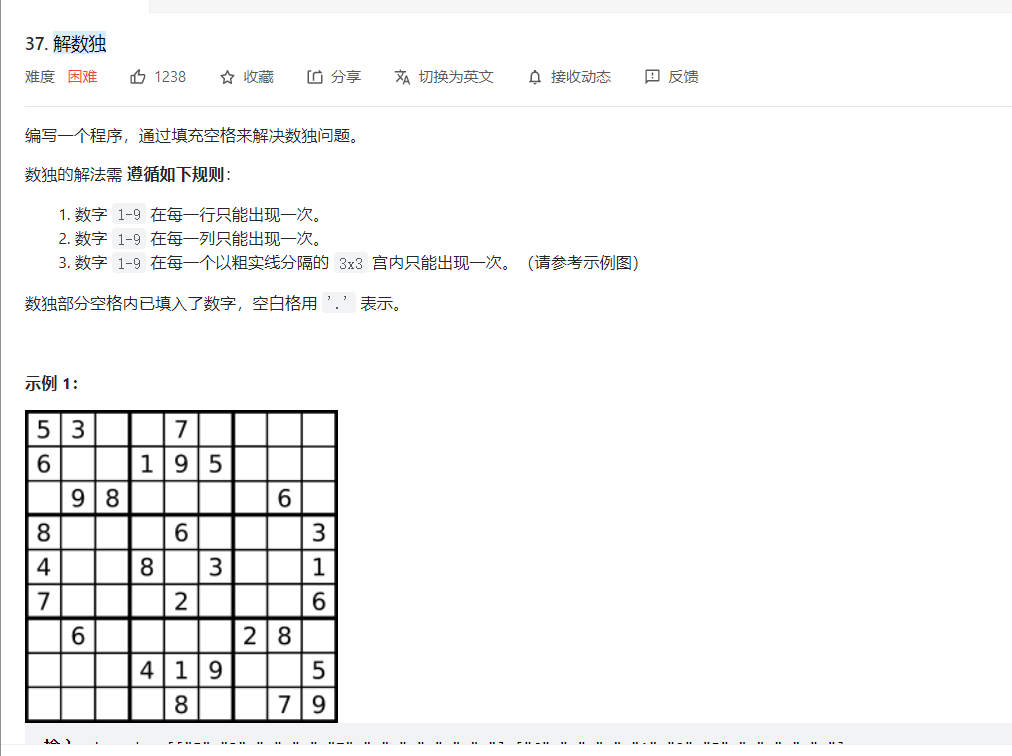1 #include<iostream>
2 #include<vector>
3 using namespace std;
4 bool othersolveSudoku(vector<vector<char>>& board, vector<vector<bool>> other, vector<vector<bool>> row, vector<vector<bool>> column, int i, int j) {
5 //找i 与 j位置后的是.的位置
6 for (; i < board.size(); i++) {
7 for (; j < board[i].size(); j++) {
8 if (board[i][j] == '.') {
9 //找到了 所以要开始从1开始试 因为下标从0开始所以是0-9
10 for (int g = 0; g < 9; g++) {
11 //这里要找到对应.位置对应的九宫格的行
12 int blockIndex = i / 3 * 3 + j / 3;
13 //判断g是否在九宫格/行/列 重复 如果不重复就填入
14 //更新九宫格/行/列 保证不重复
15 if (!other[blockIndex][g] && !row[i][g] && !column[j][g]) {
16 other[blockIndex][g] = 1;
17 row[i][g] = 1;
18 column[j][g] = 1;
19 board[i][j] = g + 48 + 1;//这里别忘记+1 48是ASCII码值 用来转换字符
20 //递归调用 如果后面的都是true即 都可以填上数字那么此轮也应该有效 直接返回true
21 if (othersolveSudoku(board, other, row, column, i, j)) {
22 return true;
23 }
24 //如果后面有不能填入数字的则应该回溯即取消当前g造成的影响 并且继续g的循环
25 else
26 {
27 row[i][g] = 0;
28 column[j][g] = 0;
29 board[i][j] = '.';
30 other[blockIndex][g] = 0;
31 }
32 }
33 }
34 //如果g全部循环完了 还是.只能说明无法填入数字 返回false
35 if (board[i][j] == '.') {
36 return false;
37 }
38 }
39 }
40 j = 0;
41 }
42 //如果没有.了 直接返回true
43 return true;
44 }
45
46 class Solution {
47 public:
48 void solveSudoku(vector<vector<char>>& board) {
49 vector<bool> load(9, 0);
50 //创建三个容器 分别记录九宫格 行 列
51 //使用int类型存放bool值 代表1-9
52 vector<vector<bool>> other(9, load);//九宫格
53 vector<vector<bool>> row(9, load);//行
54 vector<vector<bool>> column(9, load);//列
55 for (int i = 0; i < board.size();) {
56 for (int g = 0; g < 3; g++) {
57 for (int j = 0; j < board[i].size(); j++) {
58 //将char利用ASCII变为int 直接用int找下标看是否为1 是1表示已经存在返回false 不是则改为1表示存在
59 int num = board[i + g][j] - 49;
60 //将对应的数字变为1 表示已经存在过该数
61 //i + (j / 3)九宫格
62 //i + g行
63 //j列
64 if (board[i + g][j] != '.') {
65 other[i + (j / 3)][num] = 1;
66 row[i + g][num] = 1;
67 column[j][num] = 1;
68 }
69 }
70 }
71 i = i + 3;
72 }
73 //调用函数
74 othersolveSudoku(board, other, row, column, 0, 0);
75 }
76 };
77 int main() {
78 Solution sol;
79 vector<vector<char>> board = {
80 {'5','3','.','.','7','.','.','.','.'}
81 ,{'6','.','.','1','9','5','.','.','.'}
82 ,{'.','9','8','.','.','.','.','6','.'}
83 ,{'8','.','.','.','6','.','.','.','3'}
84 ,{'4','.','.','8','.','3','.','.','1'}
85 ,{'7','.','.','.','2','.','.','.','6'}
86 ,{'.','6','.','.','.','.','2','8','.'}
87 ,{'.','.','.','4','1','9','.','.','5'}
88 ,{'.','.','.','.','8','.','.','7','9'} };
89 sol.solveSudoku(board);
90 for (int i = 0; i < board.size(); i++) {
91 for (int j = 0; j < board[i].size(); j++) {
92 cout << board[i][j];
93 }
94 cout << endl;
95 }
96
97 }






 浙公网安备 33010602011771号
浙公网安备 33010602011771号